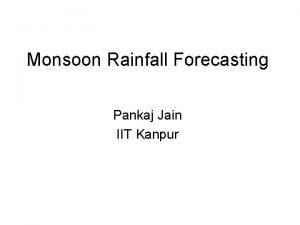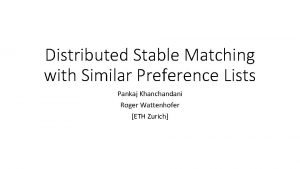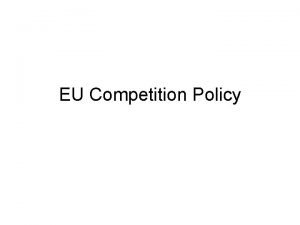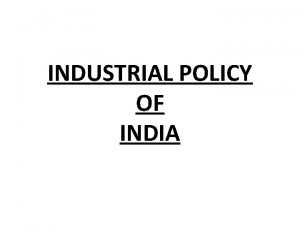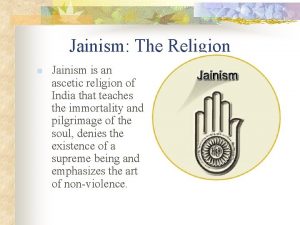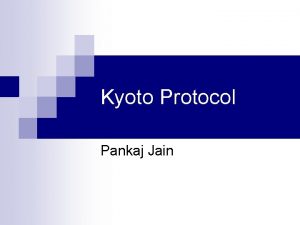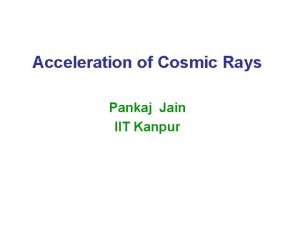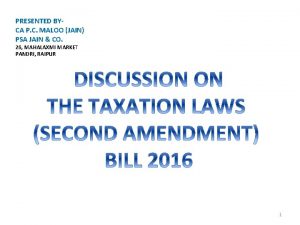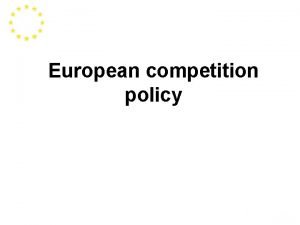Competition Policy in India an Overview Pankaj Jain


















- Slides: 18

Competition Policy in India: an Overview Pankaj Jain Faculty : Lovely Professional University

Competition Law – Definition. Modern competition law can be viewed as basic system of rules which are designed as far as possible to allow markets to function properly. It is designed to prohibit abuses of market power, whether by an individual firm or by a group of firms acting collectively, but otherwise to allow markets to operate unhindered. – Scherer and Ross (1990) Industrial Market Structure and Economic Performance.

Competition Policy Objectives n Case for competition rests mainly on ¨ economic grounds. ¨ That competition increases economic efficiency and welfare. n Political Objectives ¨ Equity ¨ Power n Market Integration

The origins of Indian Law n Directive Principles Art 38 and 39 ¨ 1. that the ownership and control of material resources of the community are so distributed as best to subserve the common good; and ¨ 2. that the operation of the economic system does not result in the concentration of wealth and means of production to the common detriment. n MRTP Act 1969 amended 1984 and then again in 1991 ¨ Primary focus was size ¨ Primary intervention was Bureaucratic n Competition in a Command Control Regime!

Indian Law Competition Act 2002 n Agreement among enterprises n Abuse of dominance n Mergers or, more generally, Combinations among enterprises n

Anti competitive agreements ¨ 3. (1) No enterprise or association of enterprises or person or association of persons shall enter into any agreement in respect of production, supply, distribution, storage, acquisition or control of goods or provision of services, which causes or is likely to cause an appreciable adverse effect on competition within India.

Approaches to Agreements Horizontal versus Vertical Agreements n Per Se n Rule of Reason n

Per Se …. n Any agreement entered into between enterprises or associations of enterprises or persons or associations of persons or between any person and enterprise or practice carried on, or decision taken by, any association of enterprises or association of persons, including cartels, engaged in identical or similar trade of goods or provision of services, which (a) directly or indirectly determines purchase or sale prices; (b) limits or controls production, supply, markets, technical development, investment or provision of services; ¨ (c) shares the market or source of production or provision of services by way of allocation of geographical area of market, or type of goods or services, or number of customers in the market or any other similar way; ¨ (d) directly or indirectly results in bid rigging or collusive bidding, ¨ ¨ shall be presumed to have an appreciable adverse effect on competition n Provided that nothing contained in this sub-section shall apply to any agreement entered into by way of joint ventures if such agreement increases efficiency in production, supply, distribution, storage, acquisition or control of goods or provision of services

Per Se Rule Minimises the costs of enforcement because removes requirement to show that an arrangement is harmful; n Risk of error reduced by limiting per se rule to behaviour that is clearly harmful. n

Rule of Reason n (4) Any agreement amongst enterprises or persons at different stages or levels of the production chain in different markets, in respect of production, supply, distribution, storage, sale or price of, or trade in goods or provision of services, including— (a) tie-in arrangement; (b) exclusive supply agreement; (c) exclusive distribution agreement; (d) refusal to deal; ¨ (e) resale price maintenance, ¨ ¨ n shall be an agreement in contravention of sub-section (1) if such agreement causes or is likely to cause an appreciable adverse effect on competition in India.

Abuse of Dominance n n n 4. (1) No enterprise shall abuse its dominant position. unfair or discriminatory condition or price (including predatory price) in purchase or sale of goods or service limits or restricts Production, Technical development Prevents Markets Access Uses dominance to enter into or protect other markets

Mergers n The acquisition of one or more enterprises by one or more persons or merger or amalgamation of enterprises shall be a combination of such enterprises and persons or enterprises, if in India, the asset value of more than rupees four thousand crores or turnover more than rupees twelve thousand crores; or outside India, in aggregate, the assets of more than two billion US dollars or turnover more than six billion US dollars; ¨ Merger or Acquisition of similar industries with assets greater than 1000 Crores or Turnover of 3000 crores …. ¨ Post Merger Size ¨ n Such Mergers are Void if they have an appreciable adverse affect on competition

Mergers & Acquisitions Till 1991: Size elements of MRTP came into play n Thereafter… n ¨ Income Tax Act ¨ SEBI Neither looks at the Market n Competition Act comes into play n


Some Concerns n High Thresholds ¨ What if it is a small merger with localized impact! ¨ Possible Areas Cement, n Ambiguous application ¨ The act restricts the CCI from investigating one year after the merger but one year from when?

The Consumer Angle n Consumer Protection is under COPRA ¨ Unfair Trade Practice - UTP provisions of MRTP now shifted exclusively to COPRA ¨ But Business access to Copra is a problem n Copra reaches to the local level ¨ But the commission does not ¨ Can they cooperate n Using Consumer Associations

The Broader Policy Domain n Govt is till an important player in economic markets ¨ As n regulator participant Supply and Demand Promoting Competition requires good Governance ü ü Participation and Political Commitment Transparency Accountability Predictability

To Conclude n Synergy between Government Action and Competition ¨ Assess all laws and government policies on the touchstone of competition ¨ All government policies should have an explicit statement about the likely impact of the policy on competition ¨ Governments at the union and the state level should frame and implement policies by acknowledging the market process ¨ Government should evolve a system of ‘competition audit’ which could be applied to all existing and future policies
 Pankaj jain kanpur
Pankaj jain kanpur Dr pankaj dadhich
Dr pankaj dadhich Pankaj malhotra pgi
Pankaj malhotra pgi Dr preetha muthusamy
Dr preetha muthusamy Pankaj khanchandani
Pankaj khanchandani Competition refers to
Competition refers to Characteristics of a monopoly
Characteristics of a monopoly Perfect competition vs monopolistic competition
Perfect competition vs monopolistic competition Market structure venn diagram
Market structure venn diagram What is competition policy
What is competition policy Industrial policy resolution in india
Industrial policy resolution in india How jainism started
How jainism started Melena management
Melena management 1 yojan in jainism
1 yojan in jainism Jain way of life
Jain way of life Lunawat
Lunawat Atap vs iip
Atap vs iip Cseo microsoft
Cseo microsoft Prateek jain msr
Prateek jain msr
